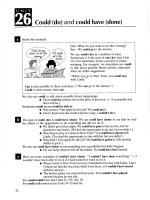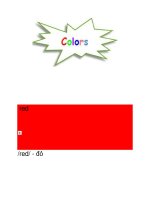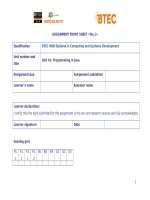1 unit 30 assignment 1 frontsheet
Bạn đang xem bản rút gọn của tài liệu. Xem và tải ngay bản đầy đủ của tài liệu tại đây (533.33 KB, 49 trang )
ASSIGNMENT 1 FRONT SHEET
Qualification
BTEC Level 5 HND Diploma in Business
Unit number and title
Unit 30: Application Development
Submission date
8/10/2023
Date Received 1st submission
Re-submission Date
8/11/2023
Date Received 2nd submission
Student Name
BUI TRAN PHUONG THAO
Student ID
GCC210031
Class
GCC1001
Assessor name
TRUNG-VIET NGUYEN
Student declaration
I certify that the assignment submission is entirely my own work and I fully understand the consequences of plagiarism. I understand that
making a false declaration is a form of malpractice.
Student’s signature
Grading grid
P1
P2
P3
M1
M2
D1
1
Summative Feedback:
Grade:
Assessor Signature:
Internal Verifier’s Comments:
Resubmission Feedback:
Date:
Signature & Date:
2
Assignment Brief 1 (RQF)
Higher National Certificate/Diploma in Computing
Student Name/ID Number:
Unit Number and Title:
Unit 30: Application Development
Academic Year:
2021 – 2022
Unit Assessor:
Hoang Nhu Vinh
Assignment Title:
Analysis and Design solution for a given problem
Issue Date:
10 May 2022
Submission Date:
Internal Verifier Name:
Date:
Submission Format:
Format: The submission is in the form of two documents/files
● An individual SRS document in PDF format. Writing must be professional.
● An individual evaluation document in PDF format. Writing must be professional.
Submission
● Students are compulsory to submit the assignment on the due date and in a way requested by the Tutor.
● The form of submission will be a soft copy posted on />● Remember to convert the word file into a PDF file before the submission on CMS.
Note:
● The individual Assignment must be your work, and not copied by or from another student.
●
If you use ideas, quotes, or data (such as diagrams) from books, journals, or other sources, you must
reference your sources, using the Harvard style.
● Make sure that you understand and follow the guidelines to avoid plagiarism. Failure to comply with this
requirement will result in a failed assignment.
Unit Learning Outcomes:
3
LO1 Produce a Software Design Document by analyzing a business-related problem and deduce an appropriate
solution including a set of initial requirements
LO2 Use design and development methodologies with tools and techniques associated with the creation of a
business application
Assignment Brief and Guidance:
Scenario: FPTBook will be a web-based software system to aid book store customers and owners to
manage their book purchases and sales about simplifying and speeding up the process of selection,
ordering, and purchasing books for customers as well as managing a database of users and a database of
products for book store owners. The attached document can view the detailed description of those roles
(Requirements.docx).
Tasks
You and your teammates (3 members/team maximum) need to prepare a software design document with
the following sections:
o A requirement specification that explores the problem by a set of user and system requirements,
as well as determines any risks related to the successful completion of your application. You are
advised to use an SRS template or modify one to complete this task.
o An evaluation section in which you research the use of software development tools and
techniques and identify any that have been selected for the development of this application. You
should compare them and justify your choices.
o A design section in which you use chosen tools from the previous step to produce design
diagrams for your solution based on the requirement specification.
4
Learning Outcomes and Assessment Criteria (Assignment 1):
Learning Outcome
LO1
Pass
P1 Explore a businessrelated problem and
produce a well-defined
Problem Definition
Statement supported by
a set of user and system
requirements.
P2 Determine any areas
of risk related to the
successful completion
of your application.
LO2
P3 Research the use of
software development
tools and techniques and
identify any that have
been selected for the
development of this
application.
Merit
M1 Analyse a businessrelated problem using
appropriate methods and
produce a wellstructured Software
Design Document that
defines a proposed
solution and includes
relevant details on
requirements, system
analysis, system design,
coding, testing and
implementation.
M2 Compare the
differences between the
various software
development tools and
techniques researched
and justify your
preferred selection as
well as your preferred
software development
methodology.
Distinction
D1 Justify the tools and
techniques chosen to
realise a custom built
website. Justify your
preferred selection of
tools and techniques in
deducing an appropriate
solution to a business
related problem.
5
Table of Contents
1.
2.
REVISIONS.........................................................................................................................................10
INTRODUCTION (P1).......................................................................................................................11
2.1. DOCUMENT PURPOSE.....................................................................................................................11
2.2. PRODUCT SCOPE.............................................................................................................................11
2.3. INTENDED AUDIENCE AND DOCUMENT OVERVIEW.......................................................................12
2.4. DEFINITIONS, ACRONYMS AND ABBREVIATIONS...........................................................................12
2.5. REFERENCES AND ACKNOWLEDGMENTS........................................................................................13
3. OVERALL DESCRIPTION (P1)......................................................................................................13
3.1. PRODUCT OVERVIEW......................................................................................................................13
3.2. PRODUCT FUNCTIONALITY.............................................................................................................14
4. SPECIFIC REQUIREMENTS (P1 & M1).......................................................................................16
4.1. FUNCTIONAL REQUIREMENTS (P1).................................................................................................16
5. USE CASE MODEL (P1)...................................................................................................................17
6. WIREFLOW (P1)................................................................................................................................23
7. RISK ASSESSMENT (P2)..................................................................................................................27
8. V. TECHNOLOGIES EVALUATION.............................................................................................31
8.1. DESIGN TOOLS..................................................................................................................................31
a. Tools to design UML.........................................................................................................................31
b. Tools to design User Interface...........................................................................................................34
c. Conclude which tools will be used for the design of the application................................................37
8.2. FRONT-END TECHNOLOGY STACK...................................................................................................37
a. Front End Programming Language...................................................................................................37
b. JavaScript Library/Framework..........................................................................................................38
c. CSS Framework.................................................................................................................................38
d. Conclusion for Front-End Technologies...........................................................................................39
8.1. BACK-END TECHNOLOGY STACK.................................................................................................39
a. Back-End Programming Language...................................................................................................39
b. Operating System..............................................................................................................................40
c. Web Server........................................................................................................................................40
d. Database............................................................................................................................................41
e. Hosting...............................................................................................................................................41
f. Frameworks........................................................................................................................................41
6
g. Conclusion for Back-End Technologies............................................................................................42
8.2. TOOLS FOR SOURCE CONTROL MANAGEMENT..........................................................................42
a. Tools for Source Control Management.............................................................................................42
b. Tools to Be Used to Manage Source Control....................................................................................43
REFERENCES..............................................................................................................................................45
7
TASK 1 – SOFTWARE REQUIREMENTS SPECIFICATIONS AND SOFTWARE
DESIGN (P1 – P2 – M1)
8
Software Requirements Specification
for
FPTBook - web-based
software system
Version <1.0>
Prepared by
Group Name: Coder Uppers
Thao
Pham
Toan
GCC210031
GCC210218
GCC210097
Instructor:
Course:
Date:
Trung-Viet Nguyen
Application Development (1670)
08/10/2023
9
1.
Revisions
Version
Primary
Author(s)
Description of Version
1.0
BUI TRAN
PHUONG
THAO
Information about the revision. This table
does not need to be filled in whenever a
document is touched, only when the
version is being upgraded.
Date Completed
12/09/2023
10
2.
Introduction (P1)
FPTBook is an innovative initiative designed to empower store owners in efficiently overseeing their
product and user databases. Additionally, it streamlines and expedites the book selection, ordering, and
purchasing journey for customers. This document provides a comprehensive overview of these roles with
intricate details.
2.1.
Document Purpose
Grasping the nuances of the software development process can be quite perplexing for the average
customer. Consequently, it becomes imperative to meticulously scrutinize and dissect requests put forth by
customers. In order to craft a product that perfectly aligns with the customer's needs, it is essential to
amass and meticulously document these requirements within a Software Requirements Specification
(SRS) document. Moreover, this SRS documentation serves as an early barometer of software complexity,
enabling us to estimate the software development activities that directly influence the quality of the end
product. This not only streamlines the overall effort but also expedites the timeline for delivering a refined
and well-executed software solution.
This Software Requirements Specification (SRS) is the development of FPTBook, a web-based software
system aimed at facilitating bookstore customers and owners in managing book purchases and sales. The
purpose of this document is to outline the requirements and specifications for the FPTBook application.
This SRS document encompasses the entire scope of the product, including both user and system
requirements, to ensure a comprehensive understanding of the project's objectives.
FPTBook intends to simplify and expedite the processes of book selection, ordering, and purchasing for
customers, while also enabling bookstore owners to efficiently manage their user and product databases.
This document will serve as a reference for the development team, providing a clear and detailed roadmap
for the design and implementation of the FPTBook application. It will also serve as a basis for
communication between stakeholders, ensuring alignment with the project's objectives and reducing the
risks associated with the successful completion of the application.
[ CITATION Gre232 \l 1033 ]
2.2.
Product Scope
FPTBook is a web-based software system accessible via smart devices connected to the internet. To use
FPTBook, individuals must visit the FPTBook website. When users are not logged in, they are considered
Guests. Guests have the ability to browse book reviews, search for books, create a new account, and log in
as Members. As Members, users retain the same privileges as Guests, with the added ability to perform
actions such as adding books to their cart, marking products as favorites, making purchases, processing
payments, updating account information, and providing product ratings. Furthermore, the system allows
shop owners to access it as Owners, granting them the capability to manage (create, read, update, delete)
products, genres, user accounts, orders, and feedback. Owners can also generate statistical reports on
11
sales, products, and the best-selling items within the system. Additionally, there is an Admin role
responsible for overseeing and approving requests from both Owners and Members.
In essence, this system was developed to provide an application that simplifies and expedites the book
selection and purchasing process for customers while also managing user and product databases for
bookstore owners.
2.3.
Intended Audience and Document Overview
This document functions as the primary user manual for individuals who plan to directly engage with the
FPT training system, including developers, project managers, testers, and end-users. It encompasses user
instructions, as well as hardware and software specifications. Prior to making any alterations, edits, or
additions to the existing system's requirements, developers should thoroughly review this document and
update the criteria accordingly. By examining the diagrams and specifications presented in this document,
users of the application can evaluate whether the software fulfills all the requirements and assess whether
the web designer has successfully implemented them. In case of any confusion, they can refer to the user
manual for additional clarification. To ensure that the initial project requirements are reflected in the final
product, testers will rely on this document to construct their test cases.
2.4.
Definitions, Acronyms and Abbreviations
No.
1
Acronyms
SRS
2
FBA
3
CRUD
4
ASP.NET
5
MVC
6
UML
Explanation
Software
requirements
specification
(SRS)
FPT
Bookstore
Application
Create,
read,
update, delete
Active
Server
Pages Network
Model-ViewController
Unified Modelling
Language
12
2.5.
References and Acknowledgments
Smith, J. (2020). "Effective Software Development Techniques." Software Development Journal, 25(3),
45-62.
flm.greenwich, 2022. Content in Requirements of assignment brief. s.l.:s.n
Brown, A. (2019). "Best Practices in Project Management." Project Management Institute.
ISO/IEC 9126-1:2001 - Software engineering - Product quality
FPT Boook Corporation Data Security Policy – Version 1.0
3. Overall Description (P1)
3.1.
Product Overview
In the present scenario, with the disappearance of physical distancing measures and the resurgence of
media buying and selling activities, there is a notable surge in internet usage that is reshaping consumer
purchasing behaviors. More and more people are opting for online platforms to browse and make
purchases. Recognizing this transformative opportunity, the FPT Group has made a strategic decision to
transition from traditional business practices to embrace e-commerce.
As part of this strategic shift, FPT Corporation is actively engaged in the development of the FPTBook
system (FBA - FPT Bookstore Application), a web-based software solution aimed at facilitating the
buying and selling of books for both customers and bookstore owners. The primary goal of this system is
to simplify and expedite the process of book selection and ordering for customers, all while efficiently
managing user and product databases on behalf of bookstore owners.
FBA has been meticulously designed to cater to the growing demands of book enthusiasts in a post-health
crisis era, offering them a convenient and secure means of accessing and purchasing books.
Simultaneously, it equips store managers with tools to streamline store operations, reduce costs, and
enable business expansion.
Within the FPTBook system, there will be two core user roles: customers and store owners. Customers
will enjoy access to features that enhance their shopping experience, including book browsing, cart
management, and order placement. In contrast, store owners will have access to management
functionalities, such as overseeing book inventory, managing catalogs, and handling orders. Additionally,
an Administrator role will be integrated into the project to monitor activities and facilitate communication
with users.
This strategic pivot by the FPT Group aligns perfectly with the evolving landscape of online commerce
and aims to deliver a seamless solution for book enthusiasts and store owners within the dynamic global
marketplace.
13
3.2.
Product Functionality
The Guest
Create an account to login to the system as a member
Search Book
View Book
Feed back
o Guest must login to manage or send feedback.
Manage shopping cart
o Guest must login to manage or send feedback.
Manage account
o Guest must login to manage or send feedback.
Register
The Admin
Manage Book
o Admin must login to manage books
o Add book
o Update Book
o Delete Book
o View Book
o Search book
Manage Order
o Admin must login to manage order
o Add order
o Update order
o Delete order
o View order
Manage Category
o Admin must login to manage category
o Add category
o Update category
o Delete category
o View category
Manage User
o Admin must login to manage category
o Add user
o Update User
o Delete user
o View user
14
o Register
The Owner
Profile
o Owner must login to manage profile
o Update profile
Manage cart
o Owner must login to manage cart
o Add cart
o Update cart
o Delete cart
o View cart
Order Book
o
15
4. Specific Requirements (P1 & M1)
4.1.
Functional Requirements (P1)
No.
1
Function
Login
Desciption
Verify
the
decentralization
and
sign-in
authenticity.
To use the
system, create a
new account.
Benefits
Send users to
the right page
where
their
rights are listed
To access the
system
and
place an order,
create
an
account.
the Search books
between data
of
Role
Admin
Owner
Guest
Built by
Thao
2
Register
Admin
Guest
Thao
3
. Search book
Search
system's
collection
books.
Show selected
book details
Send feedback
to FBA
CRUD
and
view shopping
cart
Guest
Admin
Pham
4
View Book
View details of
the book
Send feedback
to the system
Keep the items
you want to
buy in your
cart until you
have money to
spend.
The
profile
information for
your account
can
be
modified, and
you can also
delete it.
Update
information in
profile.
Keep the items
you want to
buy in your
cart until you
have money to
spend.
Allows editing
Guest
Admin
Guest
Pham
5
Feedback
6
Manage Shopping cart
Guest
Toan
7
Manage Account
CRUD
and
view account
Guest
Toan
8
profile
Update profile
Owner
Pham
9
Manage Cart
CRUD
and
view shopping
cart
Owner
Thao
10
Manage Book
CRUD
Admin
Thao
and
Pham
16
view Book
11
Manage Order
12
Manage Category
13
Manage User
book
information on
the system
CRUD
and Place
orders Admin
view order
and
make
purchases
CRUD
and Allows editing Admin
view category
category
information on
the system
CRUD
and Allows editing Admin
view user
in system
Pham
Toan
Pham
5. Use Case Model (P1)
17
Use case specifications
Use case ID
Use Case Name
By
Description
Actor(s)
UC-0
Register
Bui Tran Phuong Thao
Using this feature, a new account can be created.
Admin
Guest
18
Priority
Trigger
Must have
When a consumer wants to open a new account and purchase books but
does not already have one
Pre-Condition(s):
Post-Condition(s):
Basic Flow
Exception Flow
The system is functioning without any issues.
• The internet is connected to the guest's device.
• The guest and admin are able to access the application.
• The guest and admin are not registered with an account.
• The guest and admin are clicks on the registration button.
The register successfully. The application notifies that “Register
successfully!”
Individuals visiting the website.
The guest selects the "register" button.
On the registration page, input accurate information.
Click the "Sign Up" button to complete the process.
N/a
19
Use case ID
Use Case Name
By
Description
Actor(s)
Priority
Trigger
Pre-Condition(s):
Post-Condition(s):
Basic Flow
Exception Flow
Use case ID
Use Case Name
By
Description
Actor(s)
UC-1
Login
Bui Tran Phuong Thao
This function is utilized to gain access to the system and permits the
utilization of system functions.
Admin
Owner
Guest
Must have
Users need to have an account in the system.
User accounts have been established.
User accounts have been granted permission.
The user's device is already online during the login process.
User successfully logged into the application
The system records successful logging.
A user gains access to the system.
The user selects their preferred login method.
The user inputs their account details and selects the "login" command.
The system successfully verifies the provided credentials, granting the
user access to the application.
The system logs the instance of a successful login.
N/a
Exception Flow
UC-3
View Book
Nguyen Phi Pham
This feature is used to view detailed book information.
Guest
Admin
Have
The user wants to view the book's details.
• The system is operating as it should.
• The user device has an internet connection.
• The detail book was chosen by the user..
The user's selected book's information will be shown.
1. The user clicks detail book in step one.
2. The system shows the user-selected book's information.
N/a
Use case ID
Use Case Name
By
Description
Actor(s)
UC-5
Search Book
Nguyen Phi Pham
Use this feature to conduct a book search.
Guest
Priority
Trigger
Pre-Condition(s):
Post-Condition(s):
Basic Flow
20









